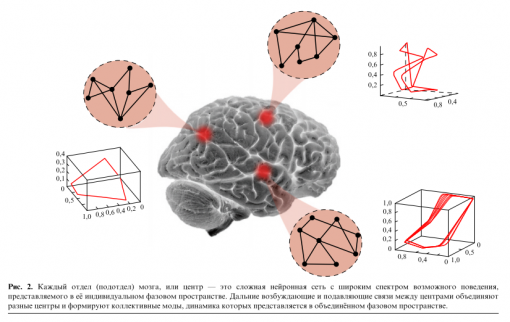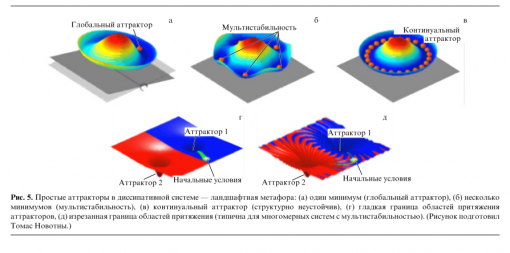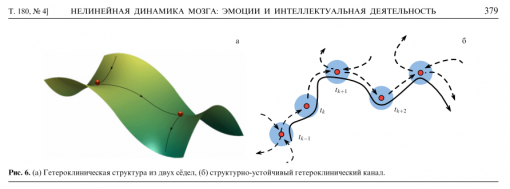Posted by Nodus Labs | April 20, 2012
Metastability of Cognitive Networks
An emerging new field of nonlinear dynamical psychiatry can provide computational methods as well as phenomenological insights for a better understanding of cognition. The core of this theory is the proposition that mental and emotional states are characterized by nonlinear dynamics and metastability. Metastability refers to the ability of the brain’s neuronal network to maintain several distinct states simultaneously, which can integrate globally to produce sensorimotor activity.
One of the most interesting papers on this subject is called “Nonlinear Dynamics of the Brain: Emotion and Cognition” published in 2010 by Rabinovich & Muezzinoglu in Physics Uspekhi journal. The English version of this article is available to subscribers only, but the Russian version is available for free. We will provide a short summary of this paper below.
Rabinovich & Muezzinoglu propose to model a dynamical system where the change of emotional and cognitive functions over time is plotted into the phase space. The data can be gathered by detecting synchronization between various groups of neurons responsible for emotional and cognitive activity (at the according frequency range and cortical locations within the brain). The authors propose to model the interaction between the emotional and cognitive processes as winner-less competition (Just & Varma 2007), using Lottke-Volter equations applied to model prey-predator dynamics. This interaction plotted in the phase space produces strange attractors, which are characteristic for open dissipative systems where the density of all interacting flows (energy, material, information) is stable (see Figures 1 and 2).
The strange attractors may be associated with a certain emotional state, cognitive activity, or memory (Rabinovich & Muezzinoglu 2010; Wills et al 2009). These local “wells” of non-equilibrium stability interact on a wider scale through the global workspace (a core network of long-range connections performing integrative function usually associated with consciousness). They synchronize at a higher gamma (30-80 Hz) frequency to produce global attractors. Small perturbations do not affect these stable states: robustness of the system (Kitano 2004) ensures that it comes back towards attractor even when disturbed. A certain level of noise ensures that the system is not “asleep” (Rabinovich et al 2008). A change in dynamics between emotion and cognition processes provokes activation of different local attractor states, which, in turn, provoke global shifts of the system. Therefore, the system is metastable in that it has several possible dynamic states but only one is actualized at every moment of time.
Local shifts in emotion-cognition dynamics provoke global shifts of the system from one state to another along a stable heteroclinic channel, which traces the transition of the system across equilibrium points over time (Rabinovich et al 2008; Rabinovich & Muezzinoglu 2010; Bystritsky et al 2012). The idea that brain networks evolve along a trajectory of attractor points accompanied by a certain level of chaotic noise was also expressed by Tsuda (2001) in his discussion of “chaotic itinerancy” found in multi-dimensional dynamical systems. Temporary global stability of such system may be referred to as mood (an state emerging as a result of global integration between various strange attractors). A study (Katerndahl et al 2007) has shown that mood transitions in mentally healthy patients have a chaotic variability.
References:
Bystritsky, a, Nierenberg, a a, Feusner, J. D., & Rabinovich, M. (2012). Computational non-linear dynamical psychiatry: A new methodological paradigm for diagnosis and course of illness. Journal of psychiatric research, 46(4), 428-435. Elsevier Ltd. doi:10.1016/j.jpsychires.2011.10.013
Katerndahl, D., Ferrer, R., Best, R., & Wang, C.-P. (2007). Dynamic patterns in mood among newly diagnosed patients with major depressive episode or panic disorder and normal controls. Primary care companion to the Journal of clinical psychiatry, 9(3), 183-7. Retrieved from http://www.pubmedcentral.nih.gov/articlerender.fcgi?artid=1911176&tool=pmcentrez&rendertype=abstract
Rabinovich, M. I., & Muezzinoglu, M. K. (2010). Nonlinear dynamics of the brain: emotion and cognition. PhysicsUspekhi, 53(4), 357-372. doi:10.3367/UFNe.0180.201004b.0371
Rabinovich, M. I., Huerta, R., Varona, P., & Afraimovich, V. S. (2008). Transient cognitive dynamics, metastability, and decision making. PLoS computational biology, 4(5), e1000072. doi:10.1371/journal.pcbi.1000072
Tsuda, I. (2001). Toward an interpretation of dynamic neural activity in terms of chaotic dynamical systems. The Behavioral and brain sciences, 24(5), 793-810; discussion 810-48. Retrieved from http://www.ncbi.nlm.nih.gov/pubmed/12239890
Wills, T. J., Lever, C., Cacucci, F., Burgess, N., & Keefe, J. O. (2009). UKPMC Funders Group Attractor Dynamics in the Hippocampal Representation of the Local Environment, 308(5723), 873-876. doi:10.1126/science.1108905.




